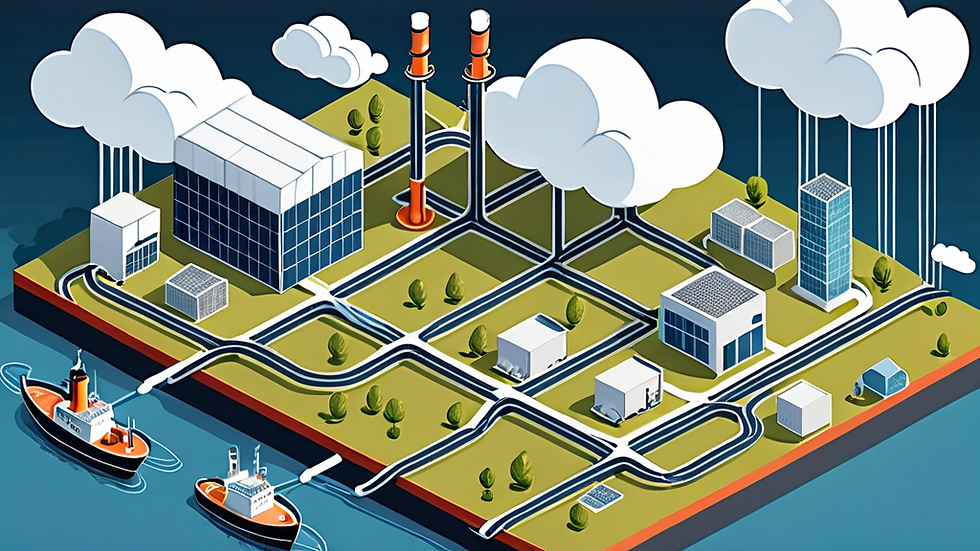Averting the Ship: How One Team Mastered Sustainable Pacing During Scaling
- Samir Haddad

- Sep 8
- 7 min read
Scaling a tech product feels like navigating treacherous waters at night with only a compass and a hope for better days. You're the captain, charting uncharted territory, fueled by adrenaline and the promise of growth. But somewhere between feature flags and market share targets, things start to feel... off.
It wasn't an epiphany moment shouting "BURNOUT!" but rather subtle signs that something was amiss. Like finding your steering wheel perpetually sticky – you think you're pushing hard, yet the ship isn’t moving as expected or feels like it's coasting through fog. Or noticing team members seem to default to 'survival mode' meetings more often than strategic ones.
This creeping unease wasn't just about fairness; it was a strategic efficiency problem brewing. Ignoring these signals felt like setting sail without a compass, heading straight for reef or worse – the productivity graveyard where burnout reigns supreme and good work crumbles under its own weight.
The Telltale Signs You're Navigating Burnout (Even When No One Says 'Burnout')

Let's be brutally honest: "burnout" is a buzzword in tech circles, sometimes overused to the point of losing meaning. But sustainable pacing isn't about dodging that specific bullet; it’s about ensuring your team operates at an optimal level long-term.
We learned to look for signs beyond the obvious stress or exhaustion narratives. Think of it like monitoring system health – you track performance dips before the server crashes entirely:
The Consistency Mirage: Suddenly, everyone is always working late or on weekends. This wasn't heroism; it was a collective dip into unsustainable zones.
Shrinking Velocity: Productivity metrics plateau even as demand increases. It's like your ship engine revs up but the hull resistance doesn't decrease proportionally – you're stuck spinning, not moving forward efficiently.
The Default Meeting Type Shift: Strategic planning meetings dwindle in favour of status updates disguised as collaboration sessions. People default to reporting distress or minor tasks when they could be tackling major ones.
These weren't just individual struggles; they were systemic symptoms pointing towards unsustainable pacing becoming a critical path blocker for the entire team's effectiveness and innovation capacity.
Our Framework for Sustainable Pacing: Beyond the Buzzwords, Into Practice

So we knew something was wrong. The trick wasn't in ignoring these signs but in building a practical framework to address them head-on. We ditched vague concepts and focused on actionable steps:
Defining "Done" with Teeth (and Kindness)
The first step was brutally honest task breakdowns. Many scaling projects fail because the initial velocity spike masks underlying work inefficiencies or incomplete understanding of scope.
We broke down feature flags: Not just "implement flag," but identified what that required – design, backend changes, frontend implementation, documentation, monitoring setup.
We tracked all activities: It wasn't enough to count story points. We started tracking actual time spent on each task type (development, testing, deployment). This helped identify bottlenecks and inefficiencies early.
Setting the Pace Realistic
Then we benchmarked our sustainable pace against this detailed work breakdown. What was achievable without stretching teams beyond their capacity for quality or innovation? Crucially:
Looked at dependencies: We considered how much of each type of task (heavy lifting, plumbing, UI) could be done concurrently versus sequentially.
Used historical velocity data wisely: Not just raw points counts, but understanding the sustainable output from previous scaling phases.
Communicating Capacity Explicitly
We started speaking openly about capacity. This was uncomfortable at first ("Why are we talking about effort? We're engineers!"), but necessary:
Defined workload types: Categorized tasks by cognitive load (brain surgery vs. filing).
Set expectations early: When estimating a new project's scope, we used the realistic sustainable pace from day one.
It wasn't just about slowing down; it was about recalibrating our entire approach to work estimation and planning towards long-term viability over short-term heroics.
Mapping Career Ladders with Intention to Fuel Motivation During Change

Scaling isn't just about shipping more – it's often a team composition change. We moved from a small, tightly-knit core to potentially hundreds of people distributed across platforms or features. This created friction and uncertainty for individuals used to specific roles and responsibilities.
We tackled this head-on by intentionally mapping career ladders:
Connecting dots: Showed engineers how scaling might mean becoming more specialized (e.g., platform engineer) or taking on broader architectural/system design roles.
Providing internal pathways: Instead of pushing everyone out into the market, we created clear ways for people to grow within our structure during periods of change. This reduced anxiety about obsolescence and provided intrinsic motivation targets.
When individuals felt they had a tangible path forward contributing meaningfully during scaling (not just after), their willingness to pace themselves improved significantly. They weren't just hoping the ship got bigger; they were seeing how it could make them better at specific, valuable things within our ecosystem. It shifted focus from "I'm worried about my job" to "How can I contribute to this exciting change?"
Team Agreements as the Compass: How We Defined Work & Well-being Together
A sustainable pace requires collective commitment and understanding of boundaries. We moved beyond top-down policies by establishing transparent team agreements:
Defining Scope: Explicitly agreed on what constituted core work versus scope creep or context switching penalties.
"We can pull in X urgent requests per week before it derails the sprint."
"This feature, while important, is a level 2 priority if we hit Y critical bugs."
Guarding Against Distraction: Agreed on boundaries around communication and notifications during focused work periods ("Deep Work Tuesdays").
"Slack be quiet for X hours unless it's blocking."
"No meetings scheduled outside of our planned blocks except at the core team level."
These agreements were powerful because they were co-created. We framed them as a shared understanding, not restrictions:
Collaborative negotiation: When priorities shifted or new demands arose, the team discussed how to accommodate them within their agreed-upon framework.
This transparency reduced hidden friction and made expectations clearer for everyone. People understood what was truly important versus the nice-to-haves that could wait until capacity allowed it.
Humanizing 1:1s: Scripts That Go Deeper Than 'How Are You?' (And Make a Difference)
Regular check-ins are essential, but generic "how are you?" often leads to generic answers or avoidance. We structured our 1:1s more effectively:
Context First: Started by discussing the team's current context – project status, challenges ahead, impact of scaling changes.
"How does working on this new platform flag rollout feel given what we agreed last sprint?"
"What support do you need to navigate these unfamiliar waters?"
Probing Questions for Deeper Insight
Then moved into more targeted questions designed to uncover real feelings and concerns:
"This week, I want to hear about one thing that energized you and one thing that drained you." (Instead of always asking about burnout)
"What's your current estimate on the priority item we discussed three sprints ago?"
This helps gauge commitment without dwelling on past issues.
"Are you able to see progress towards our agreed-upon goals this quarter? What might be blocking that visibility or momentum for you?"
The key was consistency and framing. It wasn't just about asking, but ensuring the space felt safe enough for people to share if they had something substantive to say.
Weathering Resistance: Why Sustainable Pacing Can Feel Like Going Backwards at First
Scaling with sustainable pacing is like trying to sail against a strong headwind – it requires effort and might feel counterintuitive. The most common resistance we faced wasn't about the concept itself, but its application during growth:
The Scaling Down Effect: This was our biggest hurdle. As demand increased (or felt like it should increase), people naturally wanted to do more work. Reducing scope or slowing down effort felt like failure – a step backwards rather than forwards.
We had to reframe this: "Reducing scope isn't cutting corners; it's identifying the maximum sustainable pace we can maintain without degrading quality." It was about efficiency, not incompetence.
The Discomfort of Boundaries: Setting limits on when people should focus versus communicate felt restrictive. But boundaries are necessary for focus – just like a ship needs anchor points to navigate effectively.
We focused on the positive: "These guardrails help us avoid context switching penalties and ensure everyone's deep work isn't interrupted."
It required patience, consistent reinforcement of the 'why', and celebrating small wins where sustainable pace actually allowed more impact or prevented project derailment.
The Unsexy Truth: Tracking Productivity Without the Red Flag Syndrome
This is perhaps the most crucial part. To manage demand effectively at a sustainable pace, you need visibility into capacity and utilization patterns. But doing this wrong can instantly trigger burnout:
Focus on Systems, Not Individuals (Initially)
We tracked data points like:
Effort estimates for tasks: High cognitive load tasks requiring more time.
Actual cycle times per task type: How long does it take to implement a unit test versus refactor code?
Overall project progress against capacity: Linking planned work back to the team's sustainable output rate.
But we avoided tracking individual hours unless someone asked for it meaningfully ("I'm worried I'm falling behind, can you help me track my time?"). The goal wasn't comparison but understanding:
Identifying bottlenecks: Was testing taking too long overall?
Spotting unsustainable surges: Are we consistently hitting the capacity ceiling on certain types of work?
Using Data Constructively
Data helped us adjust project scopes, timelines, and resource allocation without resorting to heroic overtime promises. It became a tool for collective understanding:
"Look at this – our sustainable pace allows X story points per week including design time."
"We're seeing cycle times increase for Y tasks because of Z bottleneck."
This data-driven approach allowed us to proactively adjust, preventing the situation from becoming critical and forcing individuals into unsustainable zones.
Key Takeaways
Here are the core principles we used:
Monitor System Health: Look beyond individual stress; track team velocity (time-based) against sustainable capacity.
Define Work Explicitly: Break down tasks, agree on scope boundaries, and categorize effort levels to avoid hidden assumptions about what can be done quickly.
Map Growth Paths: Help individuals see how scaling changes their role internally, providing motivation beyond just keeping busy. Connect career aspirations with sustainable contributions during change periods.
Establish Team Guardrails: Use transparent team agreements (co-created) for boundaries around work types and communication to protect focus time from context switching penalties.
Humanize Check-ins: Structure 1:1s to be proactive about well-being using specific, contextual questions rather than generic inquiries. Frame sustainable pace as a shared commitment.
Embrace the 'Slowdown': Understand that defining a sustainable pace often means adjusting scope or timelines downwards initially – this is efficiency management, not project failure.
Scaling successfully without burnout requires shifting from reactive problem-solving to proactive boundary setting and system understanding. It’s about navigating the journey with steady pacing rather than rushing headlong into disaster.




Comments